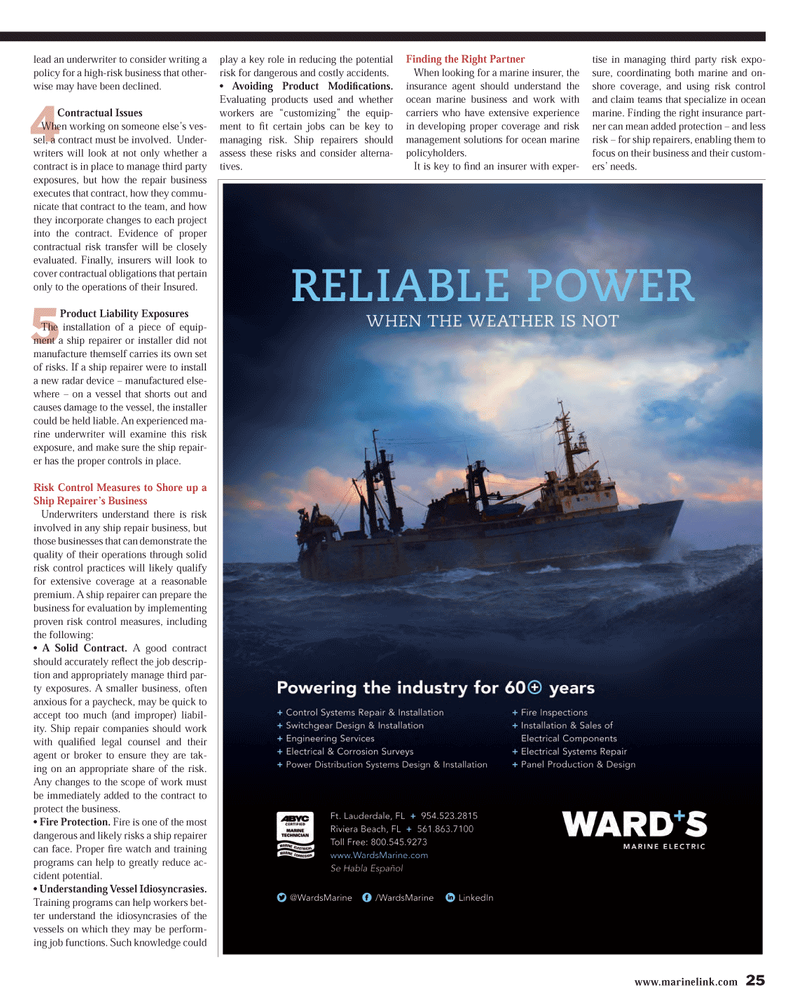
Page 25: of Maritime Reporter Magazine (October 2013)
Marine Design & Construction
Read this page in Pdf, Flash or Html5 edition of October 2013 Maritime Reporter Magazine
www.marinelink.com 2545lead an underwriter to consider writing a policy for a high-risk business that other- wise may have been declined. Contractual IssuesWhen working on someone else?s ves- sel, a contract must be involved. Under- writers will look at not only whether a contract is in place to manage third party exposures, but how the repair business executes that contract, how they commu-nicate that contract to the team, and how they incorporate changes to each project into the contract. Evidence of proper contractual risk transfer will be closely evaluated. Finally, insurers will look to cover contractual obligations that pertain only to the operations of their Insured. Product Liability Exposures The installation of a piece of equip-ment a ship repairer or installer did not manufacture themself carries its own set of risks. If a ship repairer were to install a new radar device ? manufactured else-where ? on a vessel that shorts out and causes damage to the vessel, the installer could be held liable. An experienced ma- rine underwriter will examine this risk exposure, and make sure the ship repair- er has the proper controls in place. Risk Control Measures to Shore up a Ship Repairer?s Business Underwriters understand there is risk involved in any ship repair business, but those businesses that can demonstrate the quality of their operations through solid risk control practices will likely qualify for extensive coverage at a reasonable premium. A ship repairer can prepare the business for evaluation by implementing proven risk control measures, including the following:? A Solid Contract. A good contract should accurately reß ect the job descrip- tion and appropriately manage third par- ty exposures. A smaller business, often anxious for a paycheck, may be quick to accept too much (and improper) liabil-ity. Ship repair companies should work with qualiÞ ed legal counsel and their agent or broker to ensure they are tak-ing on an appropriate share of the risk. Any changes to the scope of work must be immediately added to the contract to protect the business. ? Fire Protection. Fire is one of the most dangerous and likely risks a ship repairer can face. Proper Þ re watch and training programs can help to greatly reduce ac-cident potential. ? Understanding Vessel Idiosyncrasies. Training programs can help workers bet- ter understand the idiosyncrasies of the vessels on which they may be perform-ing job functions. Such knowledge could play a key role in reducing the potential risk for dangerous and costly accidents. ? Avoiding Product Modi Þ cations. Evaluating products used and whether workers are ?customizing? the equip-ment to Þ t certain jobs can be key to managing risk. Ship repairers should assess these risks and consider alterna-tives. Finding the Right PartnerWhen looking for a marine insurer, the insurance agent should understand the ocean marine business and work with carriers who have extensive experience in developing proper coverage and risk management solutions for ocean marine policyholders. It is key to Þ nd an insurer with exper- tise in managing third party risk expo-sure, coordinating both marine and on-shore coverage, and using risk control and claim teams that specialize in ocean marine. Finding the right insurance part-ner can mean added protection ? and less risk ? for ship repairers, enabling them to focus on their business and their custom-ers? needs. MR #10 (18-25).indd 25MR #10 (18-25).indd 2510/2/2013 3:54:25 PM10/2/2013 3:54:25 PM

 24
24

 26
26
